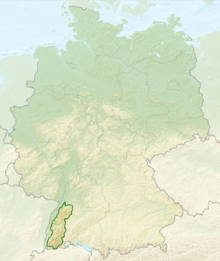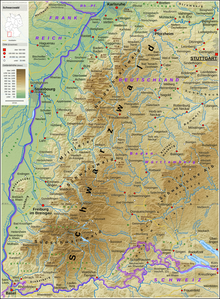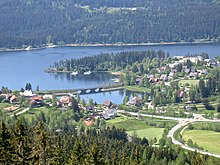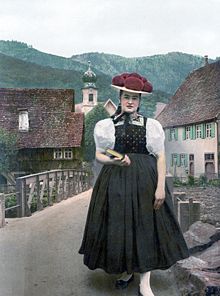Black forest
La Black Forest (in German, Schwarzwald, pronounced/хьVAtt cancellationsvalt/(![]() listen)) is a mountainous massif with a high forest density located southwest of Germany, in the federated state of Baden-Wurtemberg. In this mountainous region the highest peak is the Feldberg, with 1,493 meters of altitude. Today the Black Forest is known as a natural tourist site.
listen)) is a mountainous massif with a high forest density located southwest of Germany, in the federated state of Baden-Wurtemberg. In this mountainous region the highest peak is the Feldberg, with 1,493 meters of altitude. Today the Black Forest is known as a natural tourist site.
Etymology
One theory is that the name Black Forest may come from the area's dense fir forests that give the landscape a dark appearance. Another theory (often mentioned in the area) is that it was the Romans who gave it that name by calling it Populus nigra, perhaps inspired by the darkness that characterizes the transit and paths through the thick forests that surround it. populate. Of the two theories, the latter is the most accepted.
Geography
The Black Forest runs from the Trifinio (geographical point where Germany, Switzerland and France meet) and rises 160 km north of Germany. This vegetal band has a width that oscillates between 30 and 60 km. The main cities are Freiburg to the south and Freudenstadt to the north. It stretches from Karlsruhe in the north to Basel in the south.
Geology
Its origin is in a tectonic massif due to the split in two of a previous mountain system, by the fault that forms the Rhenish Graben, crossed by the Rhine River, giving rise to the west to the mountain range and massif from the Vosges - which is the parallel horst - and east of the Rhine, to the Black Forest.
Rivers
- Brigach and Breg, origin of the Danube.
- Kinzig, which marks the border between what is called the "North of the Black Forest" (Black Forest).Nordschwarzwald) and the "centre of the Black Forest" (Mittlerer Schwarzwald).
- Wiese, which flows south and flows into the Rhine north of Basel.
Lakes
Some of the lakes in the Black Forest are well known, such as Glaswald, Mummel, Kirnberg, Feld, Titi and Schluch, which is a very touristy place and is considered to be the largest swamp in the Black Forest, with about 7.5 km wide.
There are different reservoirs, such as the Arroyo Negro, Wehra, Witznau and the Kinzig Chico or Nagoldtalsperre reservoirs, which discharge their water in a controlled manner, thus regulating the water content of the forest.
Climate
The climate is purely mountainous, temperatures rise somewhat in summer and drop in winter, but the differences are not relevant because the forest efficiently regulates temperature changes. It is noteworthy the excess humidity, giving rise to that in some summer times it is excessively humid. The most important temperature changes occur in the rocky area.
Flora and fauna
The lush vegetation is made up mainly of ferns, firs and foxgloves.
In addition to the animal species typical of European forest wildlife such as wild boar, roe deer or red squirrels, the following endemic species can be observed in the Black Forest:
- The Black Forest cows belong to the rare breed of cattle Hinterwald.
- The giant worm Lumbricus badensis is located only in the region of the Black Forest.
- The horses of the Black Forest are an echin race proper to the forest, historically indispensable for the heavy work of the countryside.
- In some regions of the Black Forest you can find the western urogal.
History
The first cartography of the Black Forest can be found in the Tabula Peutingeriana and dates from the 14th century. The Romans always referred to the Black Forest as Marciana Silva, and it was formerly known as “Selva de la frontera” (etymology of the Germanic "marca", which meant border). It could truly be said that the Romans expressed in this way that the jungle was already a natural border to their empire, next to the limes (limit) where the Marcomans ('People of the border') lived. This population was directly related to the Germanic people of the Suevi and who later came to be derived from the Swabos (Swabia) and, due to the borders marked by the Kinzig River, the Alemanni were formed.
It deserves special mention that the Black Forest became very popular in Germany in the sixties for having served as the background for a large number of films and television series, some of them starring Roy Black and later, in the eighties, with TV series such as Black Forest Clinic.
On December 26, 1999, Hurricane Lothar (of lesser intensity than a storm) felled numerous fir trees, opening many gaps in the forest mass.
Culture
Most of the region cultivates and preserves the typical traditions and customs of the Black Forest. On the occasion of festivals or social events, many women can still be seen today wearing their regional costumes with hats (Bollenhut) with large red balls at the ends. These hats can weigh several kilos, the color of the balls (Bollen) is usually red and indicates the marital status of the woman who wears it.
The Black Forest is known for its spas (such as Baden-Baden, Bad Krozingen, Badenweiler, Bad Liebenzell or Bad Bellingen); the typical peasant houses, with a characteristic gabled roof; the Black Forest cake (Schwarzwälder Kirschtorte); Black Forest ham; the Schwarzwaldwichtel (a kind of forest sprite); Kirschwasser cherry brandy; and cuckoo clocks.
Typical gastronomy
One of the best-known delicacies of German cuisine is the famous Black Forest cake (Schwarzwaldtorte), made with cream, chocolate and berries. In pastry, honey with its fruity flavors is well known. Not to be overlooked are the famous German wines (mostly white), which can be tasted in this region on the occasion of the innumerable winegrowers' festivals that take place after the grape harvest. These wines have a low alcoholic content and refresh as well as cheer you up. These festivals offer a multitude of typical dishes of the region that are related to wine, one of them being Zwiebelkuchen ('onion pie'), often accompanied by Federweißer (young wine).
In the field of sausages, Black Forest hams are well known in the area, as well as bacon, which are usually smoke-cured which gives them a very special flavor. In Musbach there is a plant for curing hams in this traditional way.
It is common to see game meat in regional dishes, such as roe deer or wild boar; one of the most famous cuts is the chopped roe buck tenderloin accompanied by Spätzle (very typical pasta from southern Germany).
Economy
Mining
It has been known since the Romans that the Black Forest contains ores of different metals, such as silver, for example in the Münstertal.
Forestry industry
Wood from the forest is used intensively in Germany to obtain pulp and other derivatives, although great care is taken so that the forest mass does not diminish in the near future, since a century ago it ended with 90 % of trees in the entire area.
Glass production
There are several blown glass factories, especially in the city of Wolfach.
Precision Industry
The Black Forest is not only renowned for its tourist attractions, but also because it is possible to find watch parts factories for the Swiss industry in the middle of the forest (see the watch industry in the Black Forest). The brands Saba, Harman/Baker and others are known.
Tourism
In the field of tourist activities, various sports can be practiced, such as bathing and swimming in the many natural lakes, as well as paragliding, hot air ballooning, kayaking, climbing, horse riding, skiing (in winter seasons), etc.
Rural tourism
Rural tourism is very important in the area, as it offers natural landscapes in the heart of continental Europe, life in the open air and sports such as hiking trails (perfectly signposted), such as the high route of the Black Forest from Baden-Baden to Freudenstadt. It is possible to do mountain biking on some of these routes. The Thermal Palace in Bad Wildbad is well known.
The Triberg waterfalls are of interest, as is the Europa Park in Rust. In Furtwangen and Donaueschingen you can see the source of the Danube River. Another natural tourist attraction are the lakes Titisee and Schluchsee, as well as the climb to the highest mountain in the Black Forest, the Feldberg (1,493 m).
Hiking
There are different routes for hiking, all of them very well documented in books and maps that can be purchased in bookstores in the region. The best known are:
- Westweg: Pforzheim long route to Basel
- Mittelweg: Pforzheim long route to Waldshut
- Ostweg: Pforzheim long route to Schaffhausen
- Hansjakobweg I: 3-day circular route approximately
- Hansjakobweg II: circular route of about 4 days
- Querweg Rottweil-Lahr: 4-day route approximately
- Querweg Gengenbach-Alpirsbach: path that takes 2 or 3 days
- Kingiztäler Jakobusweg or Camino de Santiago del valle del Kinzig, which has 7 stages.
Museums
There are many interesting museums, such as the museum of the German writer Hermann Hesse in Calw, the Center for Media Art and Technology in Karlsruhe, the Vitra design in Weil am Rhein, and the German Watch Museum (Deutsches Uhrenmuseum), located in Furtwangen, with a variety of automata and clocks of all sizes and varieties.
There is a museum of peasant houses called Vogtsbauernhof, in Gutach an der Schwarzwald, which reproduces peasant life from the 16th and 17th centuries.
The town of Bad Säckingen has an interesting trumpet museum, as well as the oldest walkable wooden bridge in Europe.
In St. Blasien you can find an impressive church with the third largest dome in Europe.
Black Forest Clocks
The area is famous for cuckoo clocks that were once made and sold (although the Swiss are now credited with their invention), for example in Schonach and Triberg, where one of the oldest cuckoo clocks can be seen. largest in the world (mentioned in the Guinness Book of Records).
Cities
- Freudenstadt has the largest market square in all of Germany; in the vicinity is the Bärenschlössle with a batch.
- Fribourg de Brisgovia has an old Gothic cathedral, some castles and museums.
Contenido relacionado
Banff National Park
Annex: Municipalities of the province of Palencia
Kitamoto (Saitama)








